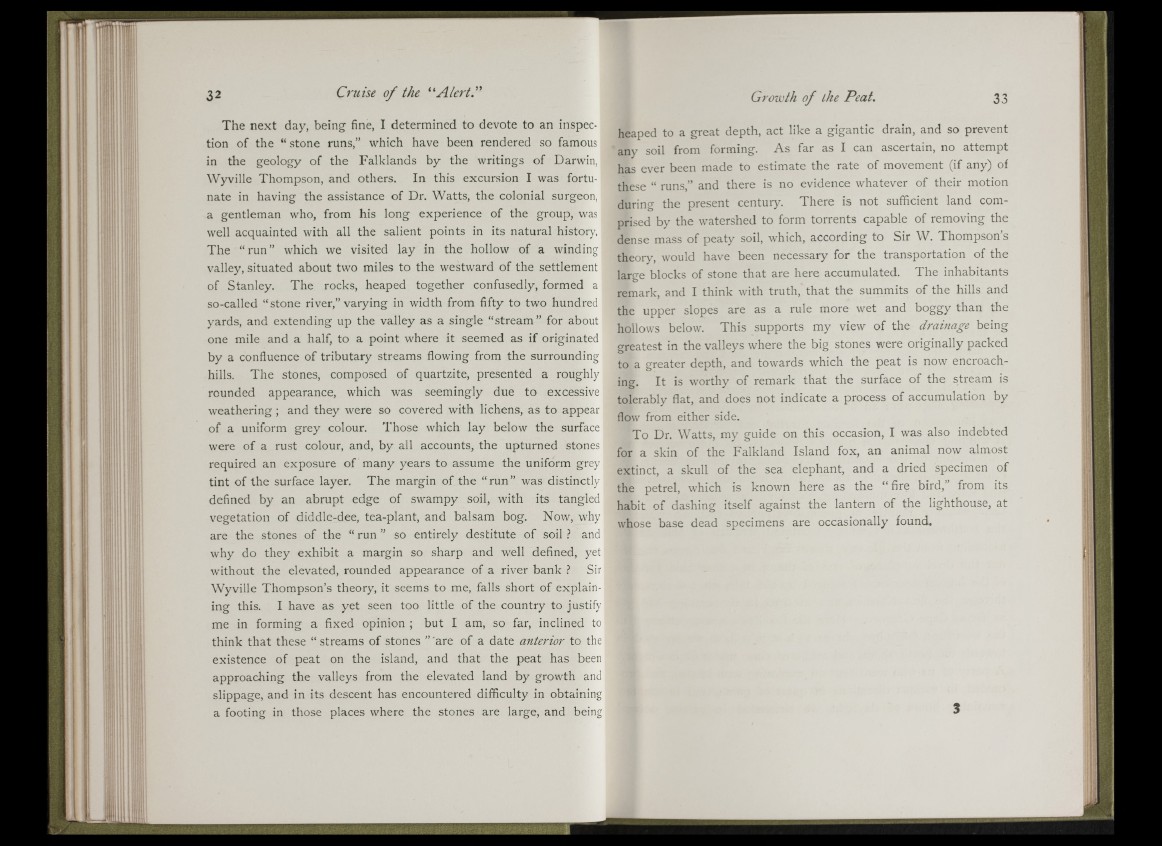
< t i t
Mi
lit
iii
lil
ill
IT"
The next day, being fine, I determined to devote to an inspection
of the “ stone runs,” which have been rendered so famous
in the geology of the Falklands by the writings of Darwin,
Wyville Thompson, and others. In this excursion I was fortunate
in having the assistance of Dr. Watts, the colonial surgeon,
a gentleman who, from his long experience of the group, was
well acquainted with all the salient points in its natural history,
The “ run” which we visited lay in the hollow of a winding
valley, situated about two miles to the westward of the settlement
of Stanley. The rocks, heaped together confusedly, formed a
so-called “ stone river,” varying in width from fifty to two hundred
yards, and extending up the valley as a single “ stream” for about
one mile and a half, to a point where it seemed as if originated
by a confluence of tributary streams flowing from the surrounding
hills. The stones, composed of quartzite, presented a roughly
rounded appearance, which was seemingly due to excessive
weathering ; and they were so covered with lichens, as to appear
of a uniform grey colour. Those which lay below the surface
were of a rust colour, and, by all accounts, the upturned stones
required an exposure of many years to assume the uniform grey
tint of the surface layer. The margin of the “ run” was distinctly
defined by an abrupt edge of swampy soil, with its tangled
vegetation of diddle-dee, tea-plant, and balsam bog. Now, why
are the stones of the “ run” so entirely destitute of soil.? and
why do they exhibit a margin so sharp and well defined, yet
without the elevated, rounded appearance of a river bank .? Sir
Wyville Thompson’s theoryq it seems to me, falls short of explaining
this. I have as yet seen too little of the country to justify
me in forming a fixed opinion ; but I am, so far, inclined to
think that these “ streams of stones ” 'are of a date anterior to the
existence of peat on the island, and that the peat has been
approaching the valleys from the elevated land by growth and
slippage, and in its descent has encountered difficulty in obtaining
a footing in those places where the stones are large, and being
heaped to a great depth, act like a gigantic drain, and so prevent
any soil from forming. As far as I can ascertain, no attempt
has ever been made to estimate the rate of movement (if any) of
these “ runs,” and there is no evidence whatever of their motion
during the present centuryL There is not sufficient land comprised
by the watershed to form torrents capable of removing the
dense mass of peaty soil, which, according to Sir W. Thompson’s
theory, would have been necessary for the transportation of the
large blocks of stone that are here accumulated. The inhabitants
remark, and I think with truth, that the summits of the hills and
the upper slopes are as a rule more wet and boggy than the
hollows below. This supports my view of the drainage being
greatest in the valleys where the big stones were originally packed
to a greater depth, and towards which the peat is now encroaching.
It is worthy of remark that the surface of the stream is
tolerably flat, and does not indicate a process of accumulation by
flow from either side.
To Dr. Watts, my guide on this occasion, I was also indebted
for a skin of the Falkland Island fox, an animal now almost
extinct, a skull of the sea elephant, and a dried specimen of
the petrel, which is known here as the “ fire bird,” from its
habit of dashing itself against the lantern of the lighthouse, at
whose base dead specimiens are occasionally' found.
LJi